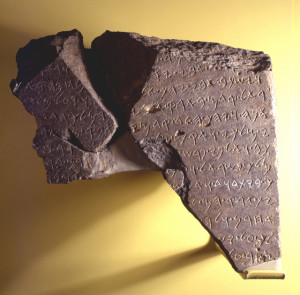
The “House of David” Inscribed on a Victory stele, Tell Dan, Basalt, Israelite period, 9th c. BCE, H. 32 cm, W. 22 cm, IAA 96-125/ 93-3162
Dan, 921 B.C., 5 a.m.- King Jeroboam I of Israel sits on a stone bench in the entranceway to the walled city of Dan and watches Israelite laborers and slaves construct an altar for the golden calf. A stonecutter, wearing a sheepskin loin cloth, swings his stone hammer, putting the final touches on a basalt slab. Another worker levels the foundation with a plumb line, then takes measurements by extending a strip of flax. Nearby, a mason pours mud into a wooden form and waits for the sun to bake the bricks.
Tel Dan, 1982 A.D., 5 a.m.- I sit on a picnic table bench shaded by a giant eucalyptus tree and the spirit of King Jeroboam. Forty other archaeological volunteers, dressed in “I Dig Dan” T-shirts and torn Levis, gather with me near the tool shed at the head of the path leading to the icy waters of the River Dan. Pickaxes stand soaking in troughs to keep their wooden handles from splitting. Small handpicks, brushes and sieves wait to be loaded into wheelbarrows. Over a kerosene stove, coffee boils and bent metal pick heads are repaired. The blacksmith, a Bible professor from a North Carolina seminary, hammers the red-hot metal. Soon the picks will be ready for another day’s battle with basalt foundations.
Excerpted from “Thoughts in the Dirt at Dan,” Daniel S. Wolk, sidebar to “Excavation Opportunities 1984,” BAR, Jan/Feb 1984.